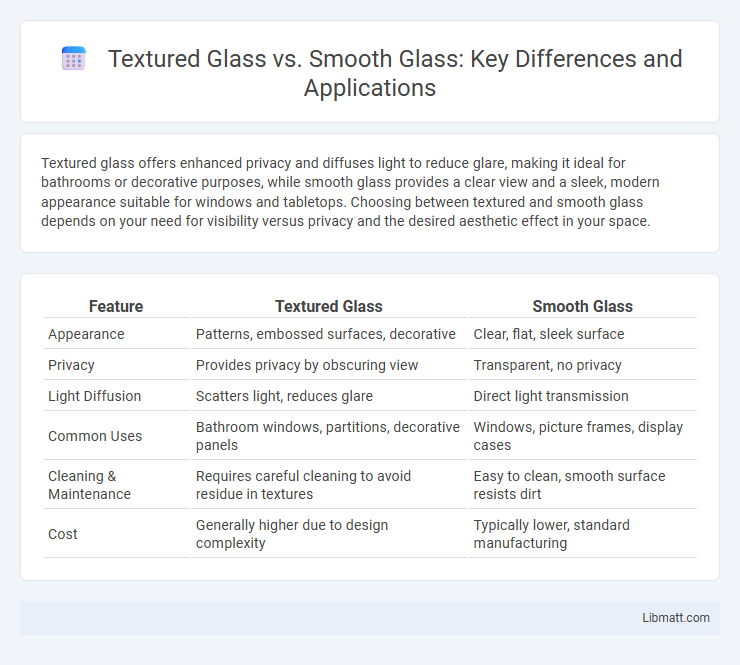Textured glass offers enhanced privacy and diffuses light to reduce glare, making it ideal for bathrooms or decorative purposes, while smooth glass provides a clear view and a sleek, modern appearance suitable for windows and tabletops. Choosing between textured and smooth glass depends on your need for visibility versus privacy and the desired aesthetic effect in your space.
Table of Comparison
| Feature | Textured Glass | Smooth Glass |
|---|---|---|
| Appearance | Patterns, embossed surfaces, decorative | Clear, flat, sleek surface |
| Privacy | Provides privacy by obscuring view | Transparent, no privacy |
| Light Diffusion | Scatters light, reduces glare | Direct light transmission |
| Common Uses | Bathroom windows, partitions, decorative panels | Windows, picture frames, display cases |
| Cleaning & Maintenance | Requires careful cleaning to avoid residue in textures | Easy to clean, smooth surface resists dirt |
| Cost | Generally higher due to design complexity | Typically lower, standard manufacturing |
Introduction to Textured and Smooth Glass
Textured glass features patterns or embossed designs that scatter light, providing privacy while enhancing aesthetic appeal in interior and exterior applications. Smooth glass offers a clear, transparent surface that maximizes visibility and light transmission, commonly used in windows, doors, and display cases. Both types serve distinct functional and decorative purposes depending on privacy needs and design preferences.
Key Differences Between Textured and Smooth Glass
Textured glass features patterns or raised surfaces that diffuse light and provide privacy, while smooth glass offers a clear, unobstructed view with maximum transparency. Textured glass is often used in bathroom windows or decorative applications to obscure visibility, whereas smooth glass is preferred for picture windows or storefronts to showcase clarity. Durability and maintenance can differ, with textured glass sometimes being more challenging to clean due to its uneven surface compared to the easy-to-clean smooth glass.
Aesthetic Appeal: Textured vs Smooth Glass
Textured glass offers a unique aesthetic appeal by adding depth, dimension, and privacy while diffusing light to create soft visual effects. Smooth glass provides a sleek, modern look with clear transparency that enhances natural light and showcases unobstructed views. Choosing between textured and smooth glass depends on your design preference for either intricate patterns or minimalist clarity.
Light Diffusion and Privacy Features
Textured glass offers superior light diffusion by scattering light evenly, reducing glare while maintaining privacy through its patterned surface, making it ideal for bathroom windows and office partitions. Smooth glass allows clear, unobstructed views and transmits maximum natural light but provides minimal privacy without additional treatments like curtains or films. Choosing textured glass enhances Your space by balancing brightness and seclusion in a stylish, functional way.
Applications in Interior Design
Textured glass enhances privacy and adds decorative elements in interior design, making it ideal for bathroom windows, office partitions, and cabinet doors where light diffusion is needed without sacrificing style. Smooth glass offers a sleek, modern aesthetic favored for open-concept spaces, glass railings, and large windows, providing clear views and a minimalist look. Both types serve functional and aesthetic purposes, with textured glass prioritizing privacy and visual interest, while smooth glass maximizes transparency and light transmission.
Durability and Maintenance Comparison
Textured glass tends to be more resistant to scratches and fingerprints compared to smooth glass, enhancing its durability in high-traffic or frequently touched areas. Smooth glass is easier to clean and maintain due to its flat surface, allowing for quick removal of dirt and smudges with standard cleaning products. Your choice between textured and smooth glass should consider the balance between long-term durability and ease of maintenance based on your specific usage needs.
Cost Considerations of Each Glass Type
Textured glass typically costs more than smooth glass due to the added manufacturing processes required to create patterns and designs. Smooth glass benefits from simpler production techniques, making it a more budget-friendly option for large-scale projects or standard applications. When choosing between the two, factoring in installation complexity and potential maintenance costs can also impact the overall expenditure.
Energy Efficiency and Insulation
Textured glass enhances energy efficiency by diffusing sunlight, reducing glare, and improving natural light distribution, which helps maintain consistent indoor temperatures and lowers cooling costs. Its surface structure traps air pockets, providing better thermal insulation compared to smooth glass, which allows more direct heat transfer. This makes textured glass ideal for energy-conscious building designs seeking improved insulation and reduced energy consumption.
Choosing the Right Glass for Your Space
Textured glass offers enhanced privacy and diffuses natural light, making it ideal for bathrooms, office partitions, and decorative panels where obscured visibility is desired. Smooth glass provides a sleek, modern look with maximum clarity, perfect for windows, storefronts, and areas requiring unobstructed views. Selecting between textured and smooth glass depends on the balance between privacy needs and aesthetic preferences tailored to your specific interior or architectural design goals.
Conclusion: Which Glass Type Suits Your Needs?
Textured glass offers enhanced privacy and decorative appeal, making it ideal for bathrooms and artistic installations, while smooth glass provides clarity and ease of cleaning, perfect for windows and tabletops. Your choice depends on whether you prioritize aesthetics and obscured views or transparency and maintenance simplicity. Evaluate the specific application and environment to determine which glass type best suits your needs.
Textured glass vs smooth glass Infographic

 libmatt.com
libmatt.com